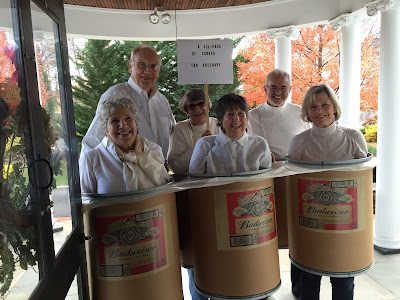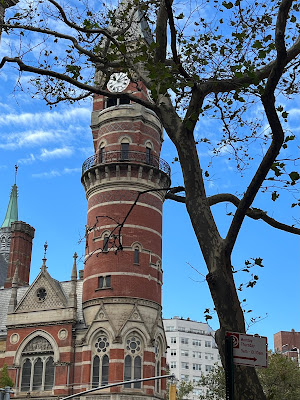Michael - alternate Thursdays
In her
post, Veracity in Historical Fiction, Annamaria invited us to consider the
constraints put on historical fiction writers by the history itself. She knows
much more about historical writing than I do, but her post seemed to me to be a
part of a bigger issue. How much of history is actually “true” and how much the probabilistic deductions of historians? Certainly there are established facts, often dates. But is that what history
is about? Surely not. It's about the lives of men and women, the political
forces and events, causes and effects. Those are much more interesting and, of
course, much harder to pin down.
This is
certainly not news to anyone. Some other takes:
"History is
a set of lies agreed upon." — Napoleon Bonaparte
"History
will be kind to me for I intend to write it." — Winston Churchill
"The past
changes a little every time we retell it." — Hilary Mantel
 |
| Richard III |
There are
thousands more in the same vein. Sometimes we are left with puzzles as complex
as any murder mystery. For example, did we ever come to a conclusion about the
Princes in the Tower? We all know this famous story of Richard III. His throne
was essentially usurped by Henry VII, who had very little title to it. It was
very important to Henry that he show that Richard III also had very little
right to the throne and was an evil and deformed man. So he set up a folio of “lies
agreed upon.” Elizabeth I had her own issues with title and didn’t need anyone
stirring up the past, so Shakespeare held to the “lies agreed upon” in his
play. That view of Richard III was largely accepted until the last century. This was certainly a case of history being written by the victors.
.png) |
| The Princes in the Tower |
Subsequently, it turned out that Richard was actually a rather good king with no physical
deformities. To this day no one knows what happened to his nephews, the princes, who
disappeared from the Tower of London and were never seen again. One (unlikely in my opinion) version has
Richard smuggling them to safety in France to save them from the evil Henry. Or maybe,
after all, Richard did have them murdered. Maybe he was neither a devil nor a
saint, but somewhere in between, as fascinating characters often are.
But what an
intriguing story! Great to write a historical novel about it! (Sorry, it’s been
done. More than once. Josephine Tey's The Daughter of Time is well known.) Yet the focus of school history seems to be around the
facts that we don’t care about all that much. Or worse. Take the South African case.
"As long as
most of us can remember, the South African history taught in our schools has
been boring. History, of course, is written by the victors and the apartheid
history curriculum was more fiction than fact. And not very good fiction
either." – Nick Dall, South African historian and author.
SA History
pre 1994 was just about the European settlers ("the good guys") versus the
existing black inhabitants ("the bad guys"). Apart from ignoring the rest of the
history of the subcontinent, the "lies agreed upon" were dressed up in a variety of ways
that ranged from deadly serious propaganda to farcical. An example of
the latter is that the picture of Jan van Riebeeck on the Rand notes introduced
when SA moved to decimal currency actually shows someone quite different—a contemporary of Jan van Riebeeck deemed to be more currencygenic than the first governor himself!
 |
Bartolomeus Vermuyden
An 18th century Dutchman who never set foot in Africa |
"If history
were taught in the form of stories, it would never be forgotten." — Rudyard
Kipling
Nick Dall
and Matthew Blackburn have recently written a book titled Legends - People who changed South Africa for the better. They try, in part, to
meet Kipling’s point by exploring the lives of a number of people who
made an impact, or tried to make an impact, on history. One of their characters is "Sailor" Malan. He was both a true war-hero flying-ace and an early campaigner against the developing policy of
apartheid, yet Malan has no place in the SA history books past or present.
Malan was born
in 1910 to an Afrikaaner family and christened Adolph Gysbert Malan. (One can
perhaps guess why his colleagues in the Royal Air Force preferred to use his nickname
“Sailor”.) In any case, having started in commercial shipping, Malan joined the RAF in England and trained as a pilot on Spitfires before the war. He led 74 Squadron during the Battle of Britain,
and was regarded as one of the RAF’s ace pilots. He finished his fighter career
in 1941 as one of the highest scoring pilots to have served wholly with RAF
Fighter Command during the Second World War, with a Distinguished Flying Cross
as well as a Distinguished Service Order. Not bad for a kid from the small Cape town of Wellington.
 |
| Sailor Malan |
 |
| Torch Commando protest |
He returned
home to South Africa in 1946 and started sheep farming. But when the right wing
National Party was voted into power and started to outline its Apartheid
agenda, he found a new role. Malan joined a liberal protest movement opposed
to the new rulers’ policies calling itself the Torch Commando. Because of his
public recognition as a war hero, he agreed to be its president. Despite its rather
belligerent name, the Torch Commando engaged in peaceful protest, appearing en
masse outside government buildings in the evening carrying burning torches. At
its peak, the movement had around 250,000 members, mostly white but with a
variety of other races represented.
However,
the split between right and left hardened as the years went on with the government
moving ever right and the ANC developing its own philosophies and a relationship with the communist party. The middle ground became all but abandoned.
Malan died of Parkinson's disease in 1963. The Apartheid government refused to allow him a military funeral and
forbade military personnel attending to wear uniforms.
The ANC regarded him
as just another white liberal unable to cross the racial divide.
Once more
the victors wrote (or, in this case, didn’t write) the history.















.jpg)

.png)



















